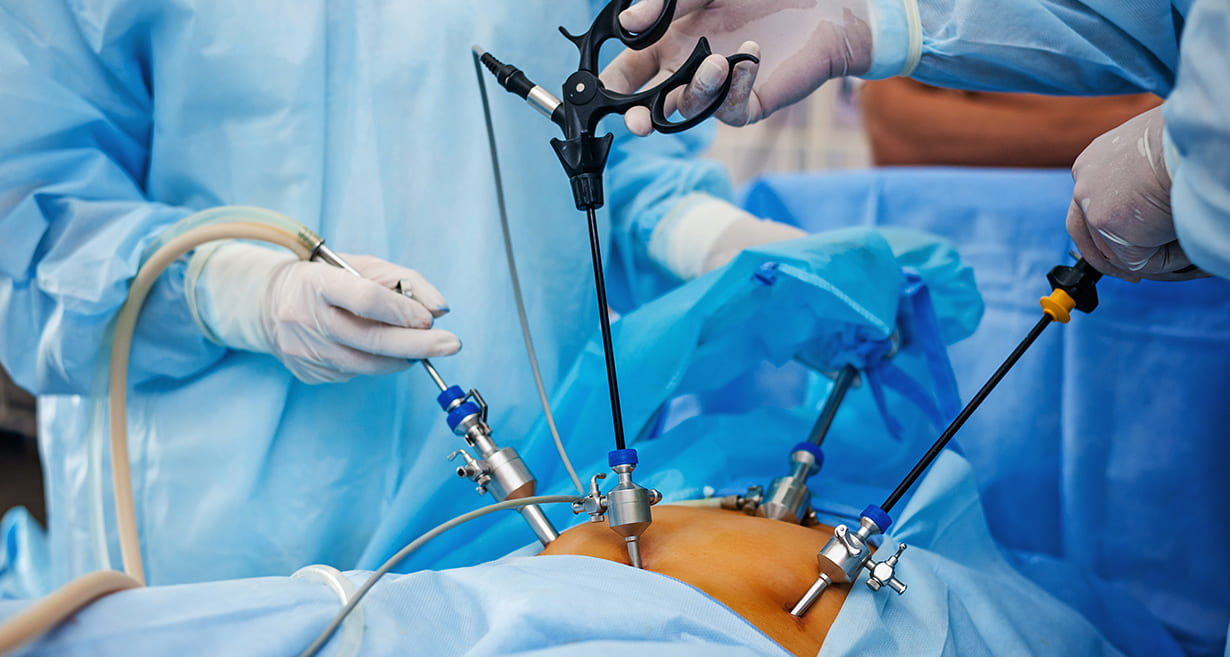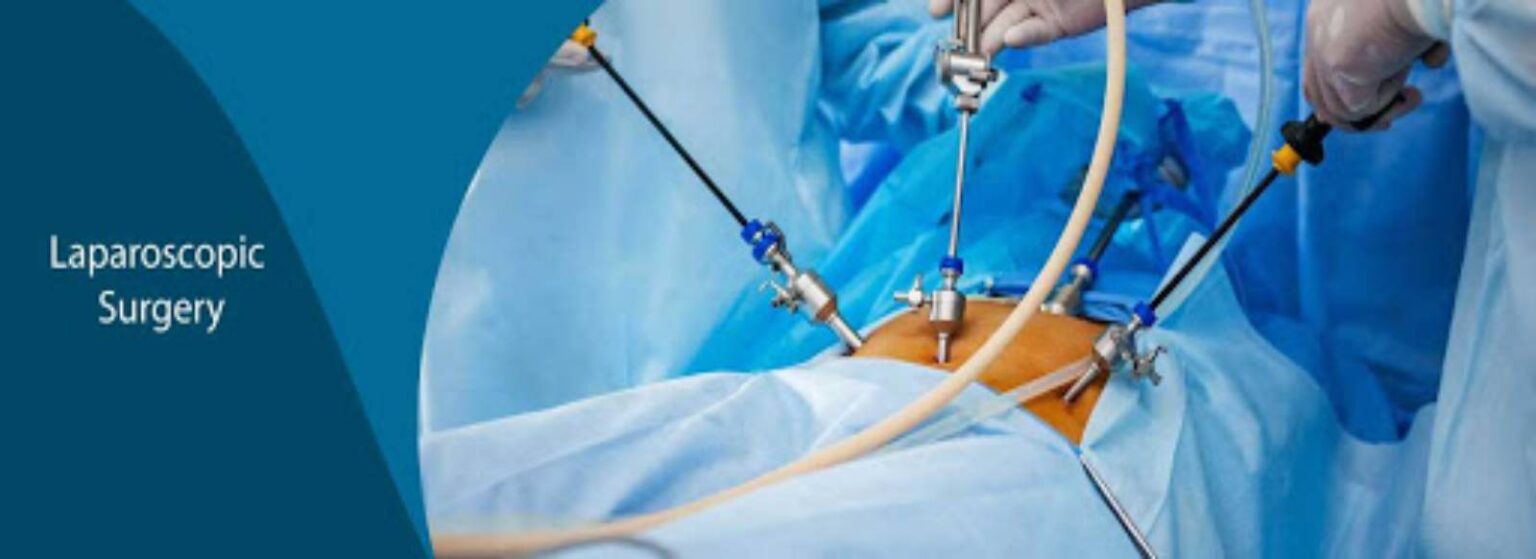Pelvic Laparoscopy Procedure
17
Feb
2022
What is Pelvic Laparoscopy?
During a pelvic laparoscopy, your doctor uses an instrument known as a laparoscope to examine your reproductive organs. A laparoscope is a long, slim tube with a high-intensity light and high-resolution camera.
Your doctor pushes the laparoscope through an incision into your abdominal wall. The camera relays pictures that are projected onto a video monitor. Your reproductive organs could be examined without performing open surgery. Your doctor could also use a pelvic laparoscopy to obtain a biopsy and treat some pelvic conditions.
Pelvic laparoscopy is known as a minimally invasive procedure because only small incisions are made. Minimally invasive procedures usually have a shorter recovery period, less blood loss, and lower levels of post-surgical pain than open surgery.

The procedure is also known as:
- Band-aid surgery
- Celioscopy
- Exploratory laparoscopy
- Gynecologic laparoscopy
- Pelviscopy
Uses of pelvic laparoscopy
Doctors use several imaging techniques to observe pelvic abnormalities. These techniques are ultrasound, CT scan, and MRI. Your doctor might use a pelvic laparoscopy after other non-invasive options have been used. The procedure might be able to provide more detail when the data gathered through these other methods cannot provide a definite diagnosis.
Your doctor could use a pelvic laparoscopy to investigate and treat conditions affecting the uterus, ovaries, fallopian tubes, and other organs in your pelvic area. Your doctor might recommend a pelvic laparoscopy to:
- Determine the cause of pelvic pain
- Examine an abnormality, like a tissue mass, ovarian cyst, or tumor, which was possibly discovered in another imaging study
- Confirm the presence of endometriosis, which is a state in which cells from the lining of your uterus grow outside of your uterine cavity
- Diagnose a pelvic inflammatory disease
- Examine your fallopian tube for blockages or ectopic pregnancy
- Investigate conditions that may cause infertility
- Monitor the extent of ovarian cancer, endometrial cancer, or cervical cancer
Your doctor could take a biopsy of the abnormal tissue during pelvic laparoscopy. They could also use the procedure to diagnose and treat specific conditions.
Using the video monitor as a guide, your doctor could:
- Obtain a tissue sample for biopsy
- Remove scar tissue or abnormal tissue from endometriosis
- Repair a damaged uterus
- Repair damage to your ovaries or fallopian tubes
- Remove an ectopic pregnancy
- Perform an appendectomy
- Carry out a hysterectomy, or removal of the uterus
- Perform a tubal ligation, which involves sterilization of your fallopian tubes
- Remove lymph nodes affected by pelvic cancers

Preparation for a pelvic laparoscopy
You generally will prepare for laparoscopy in much the same way that you would for any other surgical procedure.
You should tell your doctor about any prescription or over-the-counter medications that you are taking. Your doctor could discuss how these medications should be used before and during the test.
Specific medications could affect the outcome of your laparoscopy. Therefore, your doctor might provide special instructions if you are taking any of the following:
- Anticoagulants, or blood thinners
- Nonsteroidal anti-inflammatory drugs (NSAIDs), involving aspirin and ibuprofen
- Medications that affect blood clotting
- Herbal or dietary supplements
Let your doctor know if you are pregnant or believe you may be pregnant. This will ensure that your fetus is not harmed during the procedure.
Your doctor might request an additional imaging study, like an ultrasound, CT scan, or MRI before surgery. The data from that imaging study could help them better understand the abnormality they are investigating. The imaging results could also provide your doctor with a visual guide to your pelvic region, improving effectiveness.
You cannot eat or drink anything (including water) for at least eight hours prior to your laparoscopy. If you smoke, you might as well try to quit. Ask a friend or family member to drive you to the surgery if your doctor gives you a sedative to take at home prior to the procedure. The sedative will interfere with your ability to drive.
Procedure for pelvic laparoscopy
A pelvic laparoscopy could be done in a hospital, but it is usually performed in an outpatient clinic.
Prior to surgery, you will be asked to change into a hospital gown. An intravenous line will be inserted through your hand or arm. You will get general anesthesia in most cases. This will enable you to remain in a deep sleep and not feel any pain during the procedure.
In other cases, you will get a local anesthetic. This type of anesthesia stops you from feeling pain in your pelvic area during the procedure. Although, it will not put you to sleep. You might feel a pricking or burning sensation when your doctor injects local anesthesia into your pelvis. You might still feel pressure from the laparoscope during the procedure, but you should not feel pain.
Your doctor will make a small incision above your navel about one-half inch long once the anesthesia has taken effect. A narrow, tube-like instrument known as a “cannula” will be placed into your abdominal cavity to expand the cavity with carbon dioxide. This makes room in that region for your doctor to work. It also helps to get a clearer view.
They will then insert the laparoscope through the incision near your navel. Up to four dime-sized cuts will be done closer to your pubic hairline. These cuts allow space for additional cannulas and other tools that will be required to perform the procedure.
Your doctor might also insert a uterine manipulator through your cervix into your uterus. This will help to move the pelvic organs into view. Your doctor will remove the instruments and gas from your body and will close all of your incisions once the surgery has been completed. Bandages will be placed over the sutures used to close your incisions.

Recovery from a pelvic laparoscopy
You will need to remain in the outpatient facility or hospital for recovery and observation before you could be released. Doctors and nurses will track your vital signs, including:
- Blood pressure
- Temperature
- Pulse
- Breathing rate
The amount of time that you will need to stay in the recovery area will differ depending on your overall physical condition, the type of anesthesia that was used, and your body’s reaction to the procedure. In some cases, you might need to remain in the hospital overnight.
You will be discharged once the effects of your anesthesia have worn off. However, you would not be allowed to drive yourself home after the procedure. Have someone accompany you to the procedure so that they could drive you home.
After your pelvic laparoscopy:
- You might feel slight pain and throbbing at the surgical sites.
- You might have abdominal bloating or discomfort from the carbon dioxide for up to two days. The level of pain or discomfort should reduce each day.
- It is not uncommon to have shoulder pain after your procedure. This happens when the carbon dioxide gas causes an irritation in your diaphragm, which is a muscle that shares nerves with your shoulder.
- You might have a sore throat from the breathing tube used during the procedure.
Your doctor might prescribe medication to relieve the pain.
Every person responds differently to the procedure. Follow your doctor’s discharge instructions about when to resume normal activities, like going to work and doing physical activities. Your post-surgical instructions will depend upon the type of procedure you had.
You will be instructed not to lift any heavy objects for about three weeks after the procedure. This will lower your risk of developing a hernia in one of your incisions. You could resume your normal diet. You will need to return to your doctor in about two weeks for a follow-up visit.

Risks of a pelvic laparoscopy
Pelvic laparoscopy is regarded as a surgical procedure. The most common complications include bleeding and infection; however, these risks are minimal. Still, it is crucial to be aware of signs of infection.
Contact your doctor immediately if you have any of the following:
- Vaginal bleeding
- A menstrual flow that is uncommonly heavy or filled with clots
- Abdominal pain that increases in intensity
- Chills
- Fever
- Redness, swelling, bleeding, or drainage at your incision areas
- Continued nausea or vomiting
- Shortness of breath
A pelvic laparoscopy includes a risk of possible internal damage. Your doctor will perform immediate open surgery if an organ is punctured during the pelvic laparoscopy.
Rare complications include:
- A reaction to general anesthesia
- Inflammation or an infection of the abdomen
- A blood clot that can reach your pelvis, legs, or lungs
- A blood clot that can enter your heart or brain
- The requirement for a blood transfusion or temporary colostomy
Results of a pelvic laparoscopy
The doctor who performed your pelvic laparoscopy will evaluate the findings. If a biopsy was taken, a specialist in disease diagnosis known as a “pathologist” will examine it in a lab. A pathology report detailing the results will be forwarded to your doctor.
Normal results of a pelvic laparoscopy suggest that the reproductive organs and any other organs examined are normal in size and appearance. A normal report also indicates the absence of cysts, tumors, or other abnormalities in the pelvic area.
Abnormal laparoscopy results could indicate any one of numerous conditions including:
- Adhesions or surgical scars
- Uterine fibroids, which are benign tumors
- Cancer
- Cysts or tumors
- Endometriosis happens when tissue from the inside of your uterus grows outside of your uterus
- Hernias
- Injury or trauma
- Blockage in your fallopian tube
- Ovarian cysts
- Pelvic inflammatory disease
Your doctor might need to order more lab tests and perform more physical examinations before they are able to give you a diagnosis.
Hill Regional (HRH) Hospital is here to assist all your medical needs with specialists and surgeons trained and experienced in the most advanced treatments. Our highly qualified doctors, nurses, and administrators are dedicated to caring for you with compassion in our state-of-the-art facilities.
Call us on 254-580-8500 to book an appointment with our specialist doctors.